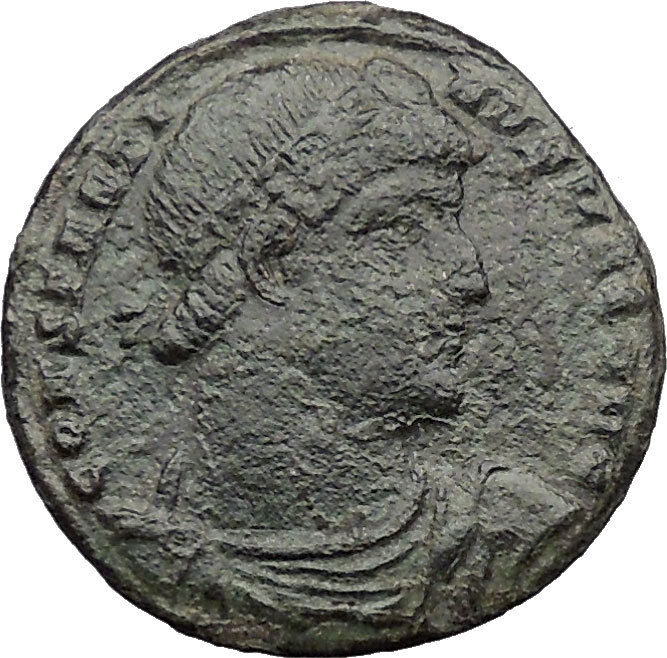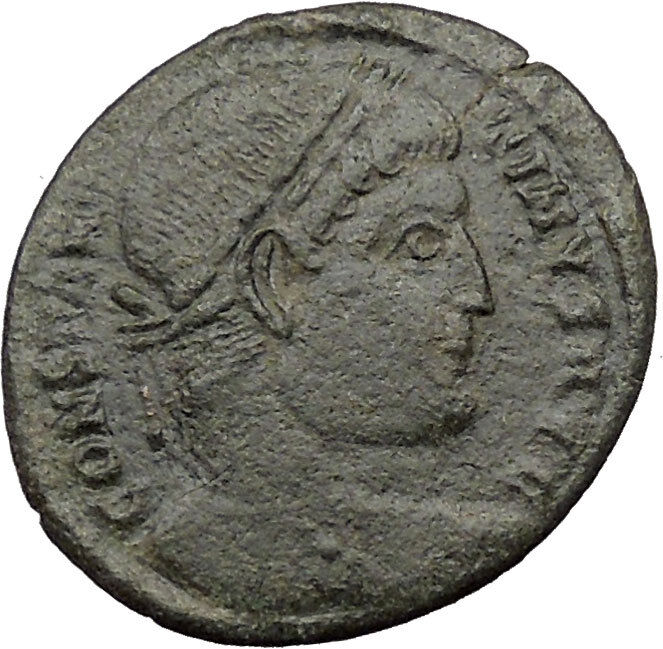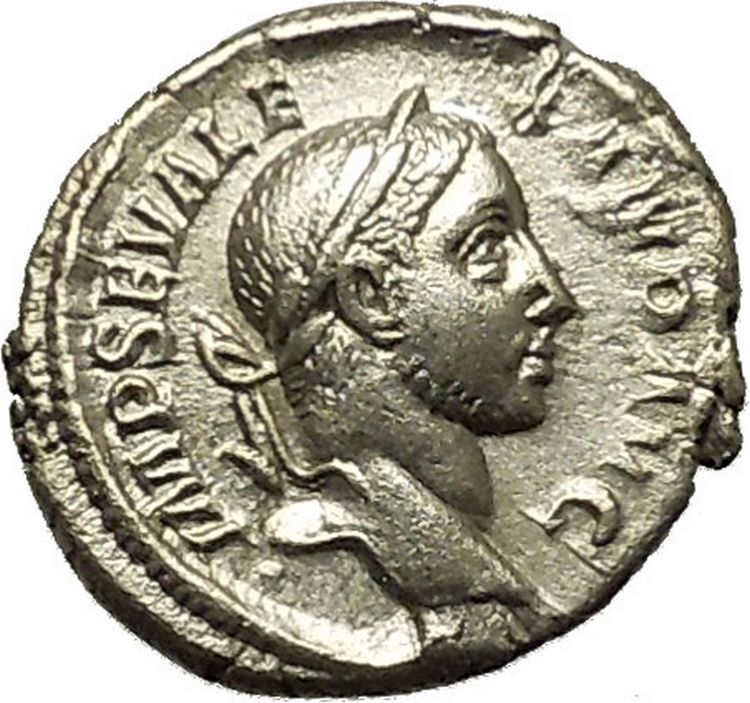|
Probus – Roman Emperor: 276-282
A.D. –
Bronze Antoninianus 22mm (3.02 grams) Ticinum mint: 281 A.D.
Reference: RIC 480h, C 121
IMPCPROBVSAVG – Radiate bust left, wearing imperial
mantle, holding scepter with eagle atop.
CONCORDMILIT Exe: Є/DXXI – Concordia standing left,
holding a standard in each hand.
You
are bidding on the exact item pictured, provided with a
Certificate of Authenticity and Lifetime Guarantee of
Authenticity.
Standards

Roman military standards. The standards with discs, or signa
(first three on left) belong to centuriae of the
legion (the image does not show the heads of the standards – whether
spear-head or wreathed-palm). Note (second from right) the
legion’s
aquila. The standard on the
extreme right probably portrays the
She-wolf (lupa) which fed
Romulus, the legendary founder of
Rome. (This was the emblem of
Legio VI Ferrata, a legion then
based in
Judaea, a detachment of which is
known to have fought in Dacia). Detail from Trajan’s Column, Rome

Modern reenactors parade with replicas of various legionary
standards. From left to right: signum (spear-head type), with
four discs; signum (wreathed-palm type), with six discs;
imago of ruling emperor; legionary aquila; vexillum
of commander (legatus) of
Legio XXX Ulpia Victrix, with
embroidered name and emblem (Capricorn) of legion
Each tactical unit in the imperial army, from centuria upwards, had
its own standard. This consisted of a pole with a variety of adornments that was
borne by dedicated standard-bearers who normally held the rank of duplicarius.
Military standards had the practical use of communicating to unit members where
the main body of the unit was situated, so that they would not be separated, in
the same way that modern tour-group guides use umbrellas or flags. But military
standards were also invested with a mystical quality, representing the divine
spirit (genius) of the unit and were revered as such (soldiers frequently
prayed before their standards). The loss of a unit’s standard to the enemy was
considered a terrible stain on the unit’s honour, which could only be fully
expunged by its recovery.
The standard of a centuria was known as a signum, which was
borne by the unit’s signifer. It consisted of a pole topped by either an
open palm of a human hand or by a spear-head. The open palm, it has been
suggested, originated as a symbol of the
maniple (manipulus=”handful”), the
smallest tactical unit in the
Roman army of the mid-Republic. The poles were
adorned with two to six silver discs (the significance of which is uncertain).
In addition, the pole would be adorned by a variety of cross-pieces (including,
at bottom, a crescent-moon symbol and a tassel). The standard would also
normally sport a cross-bar with tassels.
The standard of a Praetorian cohort or an auxiliary cohort or ala was
known as a
vexillum or banner. This was a square flag,
normally red in colour, hanging from a crossbar on the top of the pole. Stitched
on the flag would be the name of the unit and/or an image of a god. An exemplar
found in Egypt bears an image of the goddess Victory on a red background. The
vexillum was borne by a vexillarius. A legionary detachment (vexillatio)
would also have its own vexillum. Finally, a vexillum
traditionally marked the commander’s position on the battlefield.[194]
The exception to the red colour appears to have been the Praetorian Guard, whose
vexilla, similar to their clothing, favoured a blue background.
From the time of
Marius (consul 107 BC), the standard of all
legions was the
aquila (“eagle”). The pole was surmounted
by a sculpted eagle of solid gold, or at least gold-plated silver, carrying
thunderbolts in its claws (representing
Jupiter, the highest Roman god. Otherwise the
pole was unadorned. No exemplar of a legionary eagle has ever been found
(doubtless because any found in later centuries were melted down for their gold
content).
The eagle was borne by the aquilifer, the legion’s most senior
standard-bearer. So important were legionary eagles as symbols of Roman military
prestige and power, that the imperial government would go to extraordinary
lengths to recover those captured by the enemy. This would include launching
full-scale invasions of the enemy’s territory, sometimes decades after the
eagles had been lost e.g. the expedition in 28 BC by
Marcus Licinius Crassus against
Genucla (Isaccea, near modern
Tulcea, Rom., in the Danube delta region), a
fortress of the
Getae, to recover standards lost 33 years
earlier by
Gaius Antonius, an earlier
proconsul of
Macedonia.
Or the campaigns of AD 14-17 to recover the three eagles lost by
Varus in AD 6 in the
Teutoburg Forest.
Under Augustus, it became the practice for legions to carry portraits (imagines)
of the ruling emperor and his immediate family members. An imago was
usually a bronze bust carried on top of a pole like a standard by an
imaginifer.
From around the time of Hadrian (r. 117-38), some auxiliary alae
adopted the dragon-standard (draco) commonly carried by Sarmatian cavalry
squadrons. This was a long cloth wind-sock attached to an ornate sculpture of an
open dragon’s mouth. When the bearer (draconarius) was galloping, it
would make a strong hissing-sound.
Decorations
The Roman army awarded a variety of individual decorations (dona) for
valour to its legionaries. Hasta pura was a miniature spear; phalerae
were large medal-like bronze or silver discs worn on the cuirass; armillae
were bracelets worn on the wrist; and
torques were worn round the neck, or on the cuirass. The highest
awards were the coronae (“crowns”), of which the most prestigious was the
corona civica, a crown made oak-leaves awarded for saving the life of a
fellow Roman citizen in battle. The most valuable award was the corona
muralis, a crown made of gold awarded to the first man to scale an enemy
rampart. This was awarded rarely, as such a man hardly ever survived.
There is no evidence that auxiliary common soldiers received individual
decorations like legionaries, although auxiliary officers did. Instead, the
whole regiment was honoured by a title reflecting the type of award e.g.
torquata (“awarded a torque”) or armillata (“awarded bracelets”).
Some regiments would, in the course of time, accumulate a long list of titles
and decorations e.g. cohors I Brittonum Ulpia torquata pia fidelis c.R..
Probus (Latin:
Marcus Aurelius Probus
Augustus; c. 19 August 232 –
September/October 282), was
Roman Emperor from 276
to 282.

During his reign, the
Rhine and
Danube frontier was
strengthened after successful wars against several
Germanic tribes such as
the
Goths,
Alamanni,
Longiones,
Franks,
Burgundians, and
Vandals. The
Agri Decumates and much
of the
Limes Germanicus in
Germania Superior were
officially abandoned during his reign, with the Romans
withdrawing to the
Rhine and
Danube rivers.
Life
Born in 232 in
Sirmium (modern day
Sremska Mitrovica),
Pannonia Inferior, the
son of Dalmatius, Probus entered the army around 250
upon reaching adulthood. Appointed as a
military tribune by the
emperor
Valerian, he later
distinguished himself under the emperors
Aurelian and
Tacitus. He was
appointed governor of the East by Tacitus, whose death
in 276 prompted Probus’ soldiers to proclaim him
emperor.
Florianus, the
half-brother of Tacitus, was also proclaimed successor
by his soldiers, but he was killed after an indecisive
campaign.[9]
Probus travelled west, defeating the Goths along the
lower Danube in 277, and acquiring the title of
Gothicus. His position as emperor was ratified by
the
Senate around this
time.
As Emperor
In 278, Probus campaigned successfully in
Gaul against the
Alamanni and
Longiones; both tribes
had advanced through the
Neckar valley and
across the Rhine into Roman territory. Meanwhile, his
generals defeated the
Franks and these
operations were directed to clearing
Gaul of Germanic
invaders (Franks
and
Burgundians), allowing
Probus to adopt the titles of Gothicus Maximus
and Germanicus Maximus.
One of his principles was never to allow the soldiers
to be idle, and to employ them in time of peace on
useful works, such as the planting of vineyards in Gaul,
Pannonia and other districts, in order to restart the
economy in these devastated lands.[14]
Of a greater and more lasting significance, Probus began
the strategy of settling the Germanic tribes in the
devastated provinces of the empire.

Antoninianus
of Probus minted in 280. Depicts the solar
divinity
Sol Invictus
riding a
quadriga.
Probus issued many different coins during
his six years of rule.
In 279-280, Probus was, according to
Zosimus, in
Raetia,
Illyricum and
Lycia, where he fought
the
Vandals. In the same
years, Probus’ generals defeated the
Blemmyes in
Egypt. Probus then
ordered the reconstruction of bridges and canals along
the Nile, where the production of grain for the Empire
was centered.
In 280-281, Probus put down three usurpers,
Julius Saturninus,
Proculus and
Bonosus. The extent of
these revolts is not clear, but there are clues that
they were not just local problems. In 281, the emperor
was in Rome, where he celebrated his
triumph.
Probus was eager to start his eastern campaign,
delayed by the revolts in the west. He left Rome in 282,
travelling first towards Sirmium, his birth city. About
Probus’ death different accounts exist. According to
John Zonaras, the
commander of the
Praetorian Guard
Marcus Aurelius Carus
had been proclaimed, more or less unwillingly, emperor
by his troops.
Assassination (282)
Probus sent some troops against the new usurper, but
when those troops changed sides and supported Carus,
Probus’ remaining soldiers assassinated him at Sirmium
(September/October 282). According to other sources,
however, Probus was killed by disgruntled soldiers, who
rebelled against his orders to be employed for civic
purposes, like draining marshes.[24]
Carus was proclaimed emperor after Probus’ death and
avenged the murder of his predecessor.
In
Roman religion, Concord (Latin:
Concordia, “harmony”) was the
goddess of agreement, understanding, and marital harmony. Her Greek version is
Harmonia, and the Harmonians and some
Discordians equate her with
Aneris. Her opposite is Discordia (or the Greek
Eris).The
cult of Concordia
Augusta (“Majestic Harmony”) was of special importance to the
imperial household. Dedicatory inscriptions to her, on behalf of emperors
and members of the imperial family, were common. The oldest
Temple of Concord, built in
367 BC by
Marcus Furius Camillus, stood on the
Roman
Forum. Other temples and shrines in Rome dedicated to Concordia were largely
geographically related to the main temple.
|












